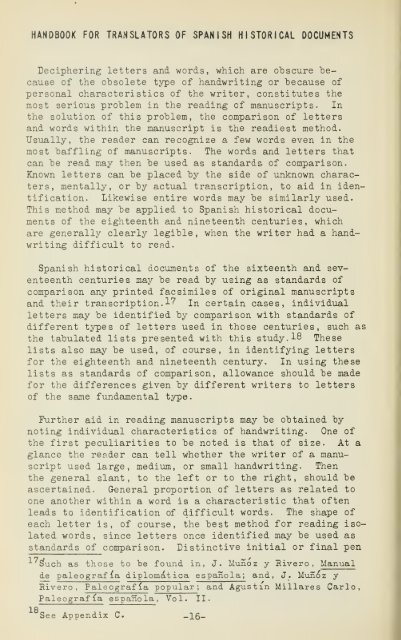Handbook for translators of Spanish historical ... - University Library
Handbook for translators of Spanish historical ... - University Library
Handbook for translators of Spanish historical ... - University Library
Create successful ePaper yourself
Turn your PDF publications into a flip-book with our unique Google optimized e-Paper software.
HANDBOOK FOR TRANSLATORS OF SPANISH HISTORICAL DOCUMENTS<br />
Deciphering letters and words, which are obscure because<br />
<strong>of</strong> the obsolete type <strong>of</strong> handwriting or because <strong>of</strong><br />
personal characteristics <strong>of</strong> the writer, constitutes the<br />
most serious problem in the reading <strong>of</strong> manuscripts. In<br />
the solution <strong>of</strong> this problem, the comparison <strong>of</strong> letters<br />
and words within the manuscript is the readiest method.<br />
UsTially, the reader can recognize a few words even in the<br />
most baffling <strong>of</strong> manuscripts. The words and letters that<br />
can be read may then be used as standards <strong>of</strong> comparison.<br />
Known letters can be placed by the side <strong>of</strong> unknown characters,<br />
mentally, or by actual transcription, to aid in identification.<br />
Likewise entire words may be similarly used.<br />
This method may be applied to <strong>Spanish</strong> <strong>historical</strong> documents<br />
<strong>of</strong> the eighteenth and nineteenth centuries, which<br />
are generally clearly legible, when the writer had a handwriting<br />
difficult to read.<br />
<strong>Spanish</strong> <strong>historical</strong> documents <strong>of</strong> the sixteenth and seventeenth<br />
centuries may be read by using as standards <strong>of</strong><br />
comparison any printed facsimiles <strong>of</strong> original manuscripts<br />
and their transcription.!''' In certain cases, individual<br />
letters may be identified by comparison with standards <strong>of</strong><br />
different types <strong>of</strong> letters used in those centuries, such as<br />
the tabulated lists presented with this study. 18 These<br />
lists also may be used, <strong>of</strong> course, in identifying letters<br />
<strong>for</strong> the eighteenth and nineteenth century. In using these<br />
lists as standards <strong>of</strong> comparison, allowance should be made<br />
<strong>for</strong> the differences given by different writers to letters<br />
<strong>of</strong> the same fundamental type.<br />
Further aid in reading manuscripts may be obtained by<br />
noting individual characteristics <strong>of</strong> handwriting. One <strong>of</strong><br />
the first peculiarities to be noted is that <strong>of</strong> size. At a<br />
glance the reader can tell whether the writer <strong>of</strong> a manuscript<br />
used large, medium, or small handwriting. Then<br />
the general slant, to the left or to the right, should be<br />
ascertained. General proportion <strong>of</strong> letters as related to<br />
one another within a word is a characteristic that <strong>of</strong>ten<br />
leads to identification <strong>of</strong> difficult words. The shape <strong>of</strong><br />
each letter is, <strong>of</strong> course, the best method <strong>for</strong> reading isolated<br />
words, since letters once identified may be used as<br />
standards <strong>of</strong> comparison. Distinctive initial or final pen<br />
Such as those to be found in, J. Muno z y Eivero , Manual<br />
de paleograffa diplomdit ica espanola; and, J. Munc^z y<br />
Eivero, Paleograffa popular; and Agustm Millares Carlo,<br />
Paleograf fa espanola. Vol. II.<br />
18 See Appendix C. -16-










![Novellen [microform] - University Library](https://img.yumpu.com/21939450/1/171x260/novellen-microform-university-library.jpg?quality=85)
![Anecdota Chisiana de re metrica [microform]](https://img.yumpu.com/21939448/1/190x239/anecdota-chisiana-de-re-metrica-microform.jpg?quality=85)



![Schollenbruch [microform] : Gedichte - University Library](https://img.yumpu.com/21939437/1/174x260/schollenbruch-microform-gedichte-university-library.jpg?quality=85)

